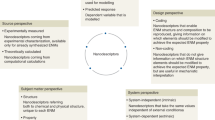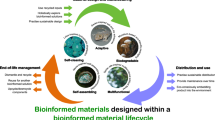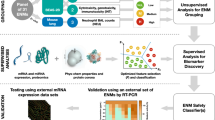Abstract
Engineered nanomaterials (ENMs) and ENM-enabled products have emerged as potentially high-performance replacements to conventional materials and chemicals. As such, there is an urgent need to incorporate environmental and human health objectives into ENM selection and design processes. Here, an adapted framework based on the Ashby material selection strategy is presented as an enhanced selection and design process, which includes functional performance as well as environmental and human health considerations. The utility of this framework is demonstrated through two case studies, the design and selection of antimicrobial substances and conductive polymers, including ENMs, ENM-enabled products and their alternatives. Further, these case studies consider both the comparative efficacy and impacts at two scales: (i) a broad scale, where chemical/material classes are readily compared for primary decision-making, and (ii) within a chemical/material class, where physicochemical properties are manipulated to tailor the desired performance and environmental impact profile. Development and implementation of this framework can inform decision-making for the implementation of ENMs to facilitate promising applications and prevent unintended consequences.
This is a preview of subscription content, access via your institution
Access options
Access Nature and 54 other Nature Portfolio journals
Get Nature+, our best-value online-access subscription
$29.99 / 30 days
cancel any time
Subscribe to this journal
Receive 12 print issues and online access
$259.00 per year
only $21.58 per issue
Buy this article
- Purchase on Springer Link
- Instant access to full article PDF
Prices may be subject to local taxes which are calculated during checkout





Similar content being viewed by others
References
Schodek, D. L., Ferreira, P. & Ashby, M. F. Nanomaterials, Nanotechnologies and Design: An Introduction for Engineers and Architects (Butterworth-Heinemann, Oxford, 2009).
Eckelman, M. J., Zimmerman, J. B. & Anastas, P. T. Toward green nano. J. Ind. Ecol. 12, 316–328 (2008).
Gilbertson, L. M., Zimmerman, J. B., Plata, D. L., Hutchison, J. E. & Anastas, P. T. Designing nanomaterials to maximize performance and minimize undesirable implications guided by the Principles of Green Chemistry. Chem. Soc. Rev. 44, 5758–5777 (2015).
Wacker, M. G., Proykova, A. & Santos, G. M. L. Dealing with nanosafety around the globe—regulation vs. innovation. Int. J. Pharm. 509, 95–106 (2016).
NSTC/CoT/NSET NNI Supplement to the President’s 2012 Budget: United States National Nanotechnology Initiative; 2011 (NNI, 2011).
NNI/NSET NNI Supplement to the President’s 2013 Budget: United States National Nanotechnology Initiative; 2012 (NNI, 2012).
NNI/NSET NNI Supplement to the President’s 2011 Budget: United States National Nanotechnology Initiative; 2010 (NNI, 2010).
NSTC/CoT/NSET NNI Supplement to the President’s 2017 Budget: United States National Nanotechnology Initiative; 2016 (NNI, 2016).
NSTC/CoT/NSET NNI Supplement to the President’s 2016 Budget: United States National Nanotechnology Initiative; 2015 (NNI, 2015).
NSTC/CoT/NSET NNI Supplement to the President’s 2015 Budget: United States National Nanotechnology Initiative; 2014 (NNI, 2014).
NSTC/CoT/NSET NNI Supplement to the President’s 2014 Budget: United States National Nanotechnology Initiative; 2013 (NNI, 2013).
NSTC/NNI/NSET NNI Supplement to the President’s 2010 Budget: United States National Nanotechnology Initiative; 2009 (NNI, 2008).
NSTC/NNI/NSET NNI Supplement to the President’s 2009 Budget; 2008 (NNI, 2008).
Zimmerman, J. B. & Anastas, P. T. Toward substitution with no regrets. Science 347, 1198–1199 (2015).
Lucht, J. M. Public acceptance of plant biotechnology and GM crops. Viruses 7, 4254–4281 (2015).
Linkov, I. & Seager, T. P. Coupling multi-criteria decision analysis, life-cycle assessment, and risk assessment for emerging threats. Environ. Sci. Technol. 45, 5068–5074 (2011).
Seager, T. P. & Linkov, I. Coupling multicriteria decision analysis and life cycle assessment for nanomaterials. J. Ind. Ecol. 12, 282–285 (2008).
van Harmelen, T. et al. LICARA nanoSCAN—a tool for the self-assessment of benefits and risks of nanoproducts. Environ. Int. 91, 150–160 (2016).
Ashby, M. F. Materials Selection in Mechanical Design (Pergamon Press, Oxford, 1992).
Karana, E., Hekkert, P. & Kandachar, P. Material considerations in product design: A survey on crucial material aspects used by product designers. Mater. & Des. 29, 1081–1089 (2008).
Ashby, M. F. Materials and the Environment: Eco-Informed Material Choice (Elsevier, Oxford, 2012).
Dicker, M. P. M. et al. Green composites: a review of material attributes and complementary applications. Compos. Part A: Appl. Sci. Manuf. 56, 280–289 (2014).
Lin, S., Zhao, Y., Nel, A. E. & Lin, S. Zebrafish: an in vivo model for nano EHS studies. Small 9, 1608–1618 (2013).
Chakraborty, C., Sharma, A. R., Sharma, G. & Lee, S.-S. Zebrafish: a complete animal model to enumerate the nanoparticle toxicity. J. Nanobiotechnol. 14, 65 (2016).
FDA issues final rule on safety and effectiveness of antibacterial soaps (ed. Fischer, A.) (US FDA, 2016).
Eftekhari, A., Li, L. & Yang, Y. Polyaniline supercapacitors. J. Power Sources 347, 86–107 (2017).
Beyth, N., Houri-Haddad, Y., Domb, A., Khan, W. & Hazan, R. Alternative antimicrobial approach: nano-antimicrobial materials. Evid. Based Complement. Altern. Med. 2015, 246012 (2015).
Gust, K. A., Collier, Z. A., Mayo, M. L., Stanley, J. K., Gong, P. & Chappell, M. A. Limitations of toxicity characterization in life cycle assessment: can adverse outcome pathways provide a new foundation? Integr. Environ. Assess. Manag. 12, 580–590 (2016).
National Research Council Risk Assessment in the Federal Government: Managing the Process Working Papers (National Academies Press, 1983).
The Global Market for Nanotechnology and Nanomaterials (Future Markets, 2016).
Lohan, S. et al. Studies on enhancement of anti-microbial activity of pristine MWCNTs against pathogens. AAPS PharmSciTech 17, 1042–1048 (2016).
Zardini, H. Z., Amiri, A., Shanbedi, M., Maghrebi, M. & Baniadam, M. Enhanced antibacterial activity of amino acids-functionalized multi walled carbon nanotubes by a simple method. Colloids Surf. B 92, 196–202 (2012).
Tayel, A. A. et al. Antibacterial action of zinc oxide nanoparticles against foodborne pathogens. J. Food Saf. 31, 211–218 (2011).
Agnihotri, S., Mukherji, S. & Mukherji, S. Size-controlled silver nanoparticles synthesized over the range 5-100 nm using the same protocol and their antibacterial efficacy. RSC Adv. 4, 3974–3983 (2014).
Misra, S. K., Dybowska, A., Berhanu, D., Luoma, S. N. & Valsami-Jones, E. The complexity of nanoparticle dissolution and its importance in nanotoxicological studies. Sci. Total Environ. 438, 225–232 (2012).
Upadhyayula, V. K. K., Meyer, D. E., Curran, M. A. & Gonzalez, M. A. Life cycle assessment as a tool to enhance the environmental performance of carbon nanotube products: a review. J. Clean. Prod. 26, 37–47 (2012).
CES Selector 2017 (Granta Design, 2017).
Lu, X., Zhang, W., Wang, C., Wen, T.-C. & Wei, Y. One-dimensional conducting polymer nanocomposites: synthesis, properties and applications. Prog. Polym. Sci. 36, 671–712 (2011).
Caballero-Guzman, A. & Nowack, B. A critical review of engineered nanomaterial release data: are current data useful for material flow modeling? Environ. Pollut. 213, 502–517 (2016).
Gilbertson, L. M. et al. Shape-dependent surface reactivity and antimicrobial activity of nano-cupric oxide. Environ. Sci. Technol. 50, 3975–3984 (2016).
Gilbertson, L. M., Goodwin, D. G., Taylor, A. D., Pfefferle, L. & Zimmerman, J. B. Toward tailored functional design of multi-walled carbon nanotubes (MWNTs): electrochemical and antimicrobial activity enhancement via oxidation and selective reduction. Environ. Sci. Technol. 48, 5938–5945 (2014).
Deng, Y. M. & Edwards, K. L. The role of materials identification and selection in engineering design. Mater. Des. 28, 131–139 (2007).
Richman, E. K. & Hutchison, J. E. The nanomaterial characterization bottleneck. ACS Nano 3, 2441–2446 (2009).
Standard Test Methods for Tension Testing of Metallic Materials, E8/E8M-13 (ASTM International, 2016).
Baker, N. A. et al. Standardizing data. Nat. Nanotech. 8, 73–74 (2013).
Mulvaney, P., Parak, W. J., Caruso, F. & Weiss, P. S. Standardizing nanomaterials. ACS Nano 10, 9763–9764 (2016).
Klaine, S. J. et al. Paradigms to assess the environmental impact of manufactured nanomaterials. Environ. Toxicol. Chem. 31, 3–14 (2012).
Acknowledgements
This publication was developed under Assistance Agreement No. RD83558001 (LCNano) awarded by the US Environmental Protection Agency (EPA). It has not been formally reviewed by the EPA. The views expressed in this document are solely those of the authors, and the EPA does not endorse any products or commercial services mentioned in this publication. This work was also supported by the National Science Foundation (NSF) Nanosystems Engineering Research Center for Nanotechnology-Enabled Water Treatment (ERC-1449500; NEWT).
Author information
Authors and Affiliations
Contributions
M.M.F., J.B.Z., D.L.P. and L.M.G. conceived and designed the reimagined framework. M.M.F. and S.S.C. performed the experiments and collected data. M.M.F. and S.S.C. analysed the data. M.M.F., S.S.C. and T.L.T. contributed materials/analysis tools. M.M.F., D.L.P., L.M.G. and J.B.Z. co-wrote the paper. All authors discussed the results and commented on the manuscript.
Corresponding author
Ethics declarations
Competing interests
The authors declare no competing interests.
Additional information
Publisher’s note: Springer Nature remains neutral with regard to jurisdictional claims in published maps and institutional affiliations.
Supplementary information
Supplementary Information
Supplementary Text, Supplementary Figure 1, Supplementary Tables 1–15
Rights and permissions
About this article
Cite this article
Falinski, M.M., Plata, D.L., Chopra, S.S. et al. A framework for sustainable nanomaterial selection and design based on performance, hazard, and economic considerations. Nature Nanotech 13, 708–714 (2018). https://doi.org/10.1038/s41565-018-0120-4
Received:
Accepted:
Published:
Issue Date:
DOI: https://doi.org/10.1038/s41565-018-0120-4
This article is cited by
-
Is the trend toward a sustainable green synthesis of copper oxide nanoparticles completely safe for Oreochromis niloticus when compared to chemical ones?: using oxidative stress, bioaccumulation, and histological biomarkers
Environmental Science and Pollution Research (2024)
-
Multi-criteria discovery, design and manufacturing to realise nanomaterial potential
Communications Engineering (2023)
-
Synthesis, characterization, safety design, and application of NPs@BC for contaminated soil remediation and sustainable agriculture
Biochar (2023)
-
Achieving sustainable nanomaterial design though strategic cultivation of big data
Nature Nanotechnology (2021)
-
Technology readiness and overcoming barriers to sustainably implement nanotechnology-enabled plant agriculture
Nature Food (2020)



